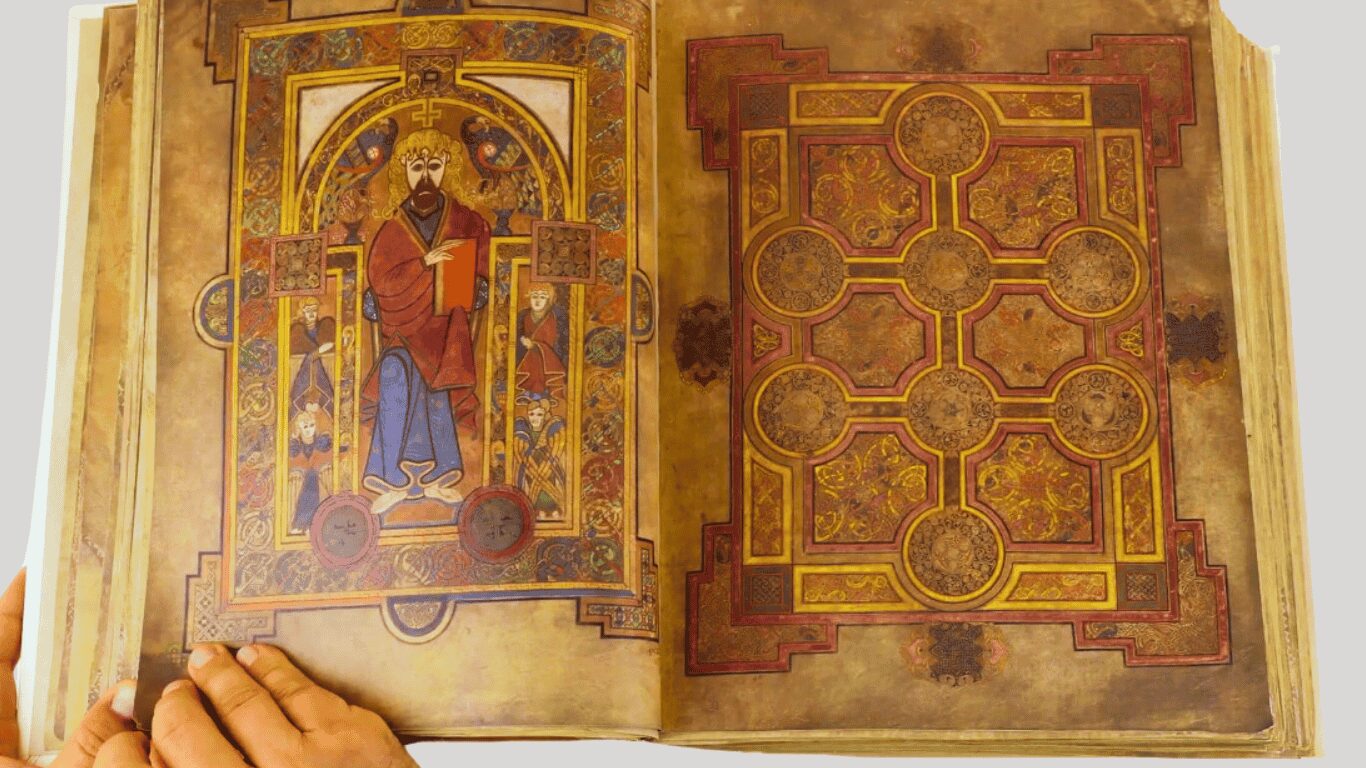Would you like to make your visit to Ireland memorable? The Book of Kells can make your visit to Ireland unforgettable because of its unique window into Ireland’s rich history and culture. This amazing manuscript, created by monks in the 9th century, is well known for its colorful illustrations and intricate designs.
After you enter Trinity College in Dublin, where the Book of Kells is kept, you will immediately feel a sense of fascination. The exhibit presents the manuscript and explains the incredible skill and dedication of the monks who developed it. As you continue your visit, you will walk through the Long Room Library, a magnificent space filled with thousands of ancient books with eternal beauty.
The combination of history, art, and atmosphere makes the experience special. So, it is a moment that stays with you long after you leave, making your trip to Ireland most unforgettable.
What is the Book of Kells
The ancient Irish text (Trinity College Dublin MS 58) contains four Gospels in Latin based on the Vulgate text, which St. Jerome completed in 384 AD. l., mixed with readings from an earlier Old Latin translation. The texts of the Gospels are introduced by other texts, including “canonical tables” or concordances of the Gospels, which are common to two or more Evangelists. They also include a summary of the Gospel narratives (Breves causae) and prefaces distinguishing the evangelists (Argumenta).
A bold and professional version of the font known as “island majuscule” was used in writing on vellum (modified calfskin). It contains 340 folios, now measuring approximately 330 x 255 mm, and were bound in the 19th century with gilded edges and a distinctive cut.
Origin of Book of Kells
The date and place of origin of this illuminated manuscript have attracted a lot of scholarly controversy. Most academic opinions now tend to attribute it to the scriptorium of Iona (Argyllshire), but conflicting claims have located it in Northumbria or Pictland in eastern Scotland. St Colum Cille founded the monastery around 561 on Iona, an island off Mull in western Scotland, and it became the principal house of a large monastic confederation.
For many years, the two monasteries were governed as a single community after the Columban monks took refuge in a new monastery at Kells, County Meath, in 806 following a raid by Vikings on the island which left 68 of the community dead. It must have been close to the year 800 when the Book of Kells was written, although there is no way of knowing whether the book was produced entirely in Iona or Kells, or partly in each place.
The History Behind the Book of Kells
This ornamental manuscript rarely appears in historical records. The Annals of Ulster, describing it as “the chief treasure of the Western world”, records that it was stolen in 1006 for its ornamental coach (shrine). It remained at Kells throughout the Middle Ages, venerated as the great Gospel book of St Colum Cille, a relic of the saint, as indicated by a poem added in the 15th century to folio 289v.
In the late 11th and 12th centuries, blank pages and gaps on folios 5v-7v and 27r were used to record property transactions relating to Kells Abbey. In 1090 the Annals of Tigernach stated that the relics of Colum Cille were brought to Kells from Donegal. These relics incorporated “two gospels”, most probably one of them is the Book of Kells, and the other is the Book of Durrow.
Following the Rebellion in 1641, the church at Kells was in ruins. In 1653, Charles Lambert, Earl of Cavan, the governor of Kells, brought the book to Dublin for security. After a few years, through Henry Jones, a former scout general in Cromwell’s army in Ireland and vice-chancellor of the university when he became bishop of Meath in 1661.
This monastic script has been on display since the mid-1800s in the Old Library at Trinity College and now attracts over 500,000 visitors a year. It has been wrapped in four volumes since 1953. Normally two volumes can be seen, one open to display the main decorated page and the other to display the two script pages.
Why is the Book of Kells Important?
The manuscript’s celebrity derives largely from the impact of its rich decoration, the extent and artistry of which are unrivalled. Abstract decorations and images of plant, animal, and human ornamentation accentuate the text to celebrate Jesus’ life and message, keeping his attributes and symbols constantly in the reader’s mind.
There are full pages of decorations for canon tables; signs of the evangelists Matthew (Man), Mark (Lion), Luke (Calf), and John (Eagle); introducing words of the Gospels; virgin and child; portrait of Christ; complex narrative scenes, first preserved in the Gospel manuscripts, representing the arrest of Christ and his temptation by the devil.
The Chi Rho page (folio 34r), representing Matthew’s account of the birth, is the single best-known page of the medieval manuscript. There are portraits of Matthew and John, but no portrait of Mark or Luke has survived. These were probably executed, like the other main pages of the manuscript, on individual leaves and are believed to have separated and been lost over time. In total, about 30 folios were lost in the Middle Ages and early modern times.
Celebrated as a UNESCO treasure, the book has become a symbol of Irish heritage, showcasing the nation’s deep cultural and artistic roots.
Where Can You See the Book of Kells Today?
The Christian iconography is one of Ireland’s most popular tourist attractions and is visited by thousands of people every year. It is located at Trinity College Dublin where it is on public display. It continues to grow in popularity and remains a source of pride for Ireland and a testament to the beauty of Celtic art.
The visit to the exhibition does not end with the Book of Kells. Upstairs, you will find the Long Room Library, one of the most stunning libraries in the world. It is a vast hall filled with towering bookshelves, rare manuscripts, and that unforgettable smell of old books. Even if you are not a history enthusiast, it is impossible not to feel awed by the atmosphere.
How much time is required to visit the Book of Kells?
You will need about 1-1.5 hours to visit the exhibition, view the medieval manuscript, and explore the Long Room Library. Arrive early to avoid crowds and fully enjoy the experience.
Is photography allowed at the exhibition?
Photography is not allowed inside the exhibition or the library to protect the manuscript and maintain a calm atmosphere for visitors.
Are children allowed to visit the Book of Kells?
Yes, younger kids might need to grasp its full significance, but older children and teens will certainly enjoy the colourful illustrations and learning about Ireland’s history in a hands-on way.
Are there any other illuminated books like the Book of Kells?
Other famous illuminated books include the Lindisfarne Gospels and the Book of Durrow. However, the Book of Kells is distinctive for its elaborate artistry and vivid colors.
Is the Book of Kells available online?
Yes, Trinity College Dublin has digitized the book and made it available online. Thus it allows people worldwide to explore the beauty and details of book of kells from anywhere.

